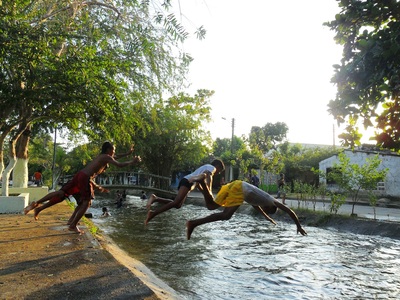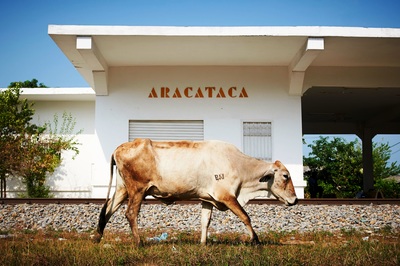"Once upon a time in the Caribbean region of Colombia, a boy was born and named little Gabriel."
|
His parents left him with his maternal grandparents in Aracataca as they returned to the wild west town of Riohacha, where they lacked support to raise children. Gabriel's grandfather, Colonel Marquez, had arrived in Aracataca as a fugitive, escaping a past haunted by a duel. Growing up, Gabriel was immersed in his family's rich history and the town's extraordinary legends. His grandmother shared magical tales of ghosts, spirits, and miracles, while his grandfather recounted adventures filled with heroism and regret. Aracataca, a melting pot of cultures and beliefs, blurred the lines between reality and fantasy.
This unique upbringing, steeped in magical realism, deeply influenced Gabriel. He explored the lush landscapes, absorbed the vibrant market scenes, and listened to the whispers of the wind through the banana plantations. These experiences shaped his understanding of the world and laid the foundation for his future as a celebrated storyteller, weaving the extraordinary into the fabric of everyday life. |
Aracataca |
Tours |
Literary Events |
Macondo Poesia |
Store |
A short history of Colombia
A short history of Colombia is intertwined with the history of Aracataca, which has become a symbol for the broader narrative of Latin America in the 20th century. One pivotal event was the United Fruit Company massacre in 1928 (now known as Chiquita). This tragic incident drew the attention of congressman Jorge Eliécer Gaitán, whose investigation and exposure of the official truth turned him into a hero for the working class across the nation.
Gaitán's rising influence suggested a promising future; it is widely believed he would have been elected president in 1949. However, his assassination in 1948 triggered El Bogotazo, a series of massive riots that devastated much of Bogotá. This event marked the beginning of La Violencia, a period of intense and widespread violence that ultimately spiraled into a civil war. This conflict, deeply rooted in Colombia's social and political fabric, has only recently seen resolution, highlighting the country's tumultuous journey through the 20th century.
Gaitán's rising influence suggested a promising future; it is widely believed he would have been elected president in 1949. However, his assassination in 1948 triggered El Bogotazo, a series of massive riots that devastated much of Bogotá. This event marked the beginning of La Violencia, a period of intense and widespread violence that ultimately spiraled into a civil war. This conflict, deeply rooted in Colombia's social and political fabric, has only recently seen resolution, highlighting the country's tumultuous journey through the 20th century.
Aracataca is the heart of Macondo
The Caribbean in Colombia is a vibrant land, teeming with life. Music fills the air on street corners, while friendly locals wander the neighborhoods selling fruits, candy, and other goods. The people are as warm and joyful as anywhere else, welcoming strangers and showing genuine interest in the world around them.
In the early 20th century, during the Banana Boom, Aracataca saw an influx of people from various parts of the world. Arab craftsmen, Italian salesmen, indigenous travelers, supervisors from the United States, and recently released African slaves all mingled in this melting pot of cultures.
Magical realism often emerges from living among diverse cultures, religions, and languages, interpreting the events of others through one's own experiences.
The banana boom, a phenomenon that swept across the Caribbean, has come to symbolize modern imperialism. Aracataca experienced rapid growth during this time, only to face economic collapse later on. Nevertheless, Aracataca endures.
Today, 100 years later, Aracataca is a wonderful destination to explore. The locals are incredibly friendly, making your visit truly immersive. Here are our recommendations for making the most of your upcoming trip.
Explore the Birthplace of Gabriel García Márquez: Visit the childhood home of the Nobel Prize-winning author to gain insight into his early life and the inspiration behind his works.
Discover the Diverse Heritage: Learn about the town's multicultural history by visiting local museums and historical sites that celebrate the contributions of Arab, Italian, indigenous, American, and African communities.
Enjoy Local Music and Dance: Let the rhythms of Caribbean music sweep you off your feet. Join the locals in their lively celebrations and dance to the beat of traditional instruments.
Immerse Yourself in Nature: Take a walk through the lush landscapes surrounding Aracataca, where the natural beauty of the region provides a serene backdrop for reflection and relaxation.
In the early 20th century, during the Banana Boom, Aracataca saw an influx of people from various parts of the world. Arab craftsmen, Italian salesmen, indigenous travelers, supervisors from the United States, and recently released African slaves all mingled in this melting pot of cultures.
Magical realism often emerges from living among diverse cultures, religions, and languages, interpreting the events of others through one's own experiences.
The banana boom, a phenomenon that swept across the Caribbean, has come to symbolize modern imperialism. Aracataca experienced rapid growth during this time, only to face economic collapse later on. Nevertheless, Aracataca endures.
Today, 100 years later, Aracataca is a wonderful destination to explore. The locals are incredibly friendly, making your visit truly immersive. Here are our recommendations for making the most of your upcoming trip.
Explore the Birthplace of Gabriel García Márquez: Visit the childhood home of the Nobel Prize-winning author to gain insight into his early life and the inspiration behind his works.
Discover the Diverse Heritage: Learn about the town's multicultural history by visiting local museums and historical sites that celebrate the contributions of Arab, Italian, indigenous, American, and African communities.
Enjoy Local Music and Dance: Let the rhythms of Caribbean music sweep you off your feet. Join the locals in their lively celebrations and dance to the beat of traditional instruments.
Immerse Yourself in Nature: Take a walk through the lush landscapes surrounding Aracataca, where the natural beauty of the region provides a serene backdrop for reflection and relaxation.
What is the meaning of Macondo
Macondo is a term rich with significance, encompassing various interpretations:
Aracataca's history, closely tied to Colombia's, shaped the literary Macondo. During the early 20th century Banana Boom, the town saw a diverse influx of people, creating a unique cultural environment. The United Fruit Company massacre in 1928 and the subsequent political turmoil influenced García Márquez’s work.
Visiting Aracataca Today
Aracataca today echoes the spirit of Macondo, offering visitors a chance to explore García Márquez's birthplace, enjoy vibrant markets, and experience the town's rich cultural heritage and natural beauty. The town's resilience and charm make it a fascinating destination for understanding the roots of magical realism.
- Symbolic Sound and State of Mind: It represents a state of mind that allows you to see what you want and how you want to see it.
- Geographical Origin: It is the name of a farm near Aracataca, Colombia, inspiring Gabriel García Márquez.
- Literary Significance: In One Hundred Years of Solitude, Macondo is the fictional town and main character, symbolizing the cyclical nature of history and the blend of reality and fantasy.
- Botanical Reference: Macondo is also a tree found in Central and South America.
- Linguistic meaning: In Bantu language, Macondo means banana.
Aracataca's history, closely tied to Colombia's, shaped the literary Macondo. During the early 20th century Banana Boom, the town saw a diverse influx of people, creating a unique cultural environment. The United Fruit Company massacre in 1928 and the subsequent political turmoil influenced García Márquez’s work.
Visiting Aracataca Today
Aracataca today echoes the spirit of Macondo, offering visitors a chance to explore García Márquez's birthplace, enjoy vibrant markets, and experience the town's rich cultural heritage and natural beauty. The town's resilience and charm make it a fascinating destination for understanding the roots of magical realism.
Our favorite Garcia Marquez books
|
Story of a Shipwrecked Sailor Everybody was supposed to be dead. An allegedly horrific storm struck the military vessel that was allegedly patrolling the seas. Gabo was faced with a reality that embedded evermore political critique and social consiousness in Gabo's works. This story made him an exile. A heroic piece of journalism. |

















